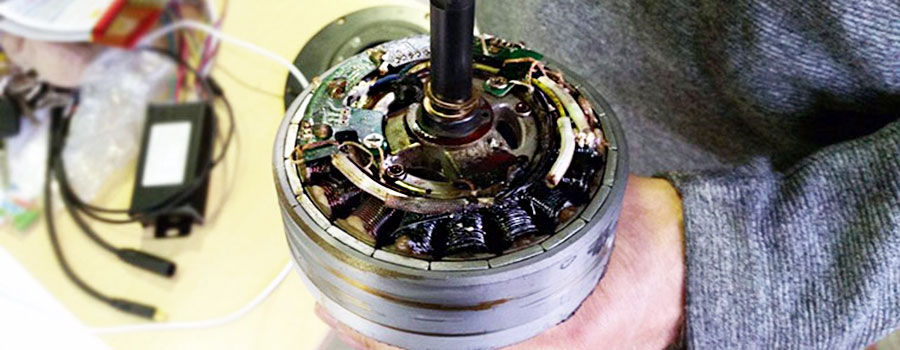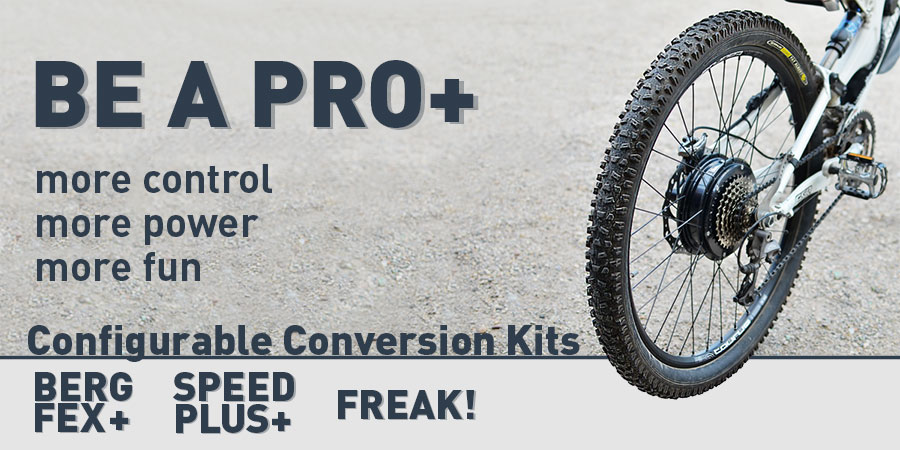Pedelec Tuning
As with any other motor vehicles like car or motorbike you can ask yourself if an electric bicycle's power can be vastly increased by tuning. Electric bicycles indeed can be tuned: Mostly you can increase the maximum speed by removing pre-adjusted restrictions.
Tuning a pedelec yet will result in loosing its legal privileges, meaning as soon as it does not conform to legal regulations it is not allowed to be operated on public roads anymore. Tuning will also void the manufacturer's warranty, in case of a damage the owner is solely responsible and will not be eligible for repair or compensation.
The more popular pedelecs and e-bikes get the more possibilities for tuning will be available on the market. There's several methods to remove an electric bicycle's throttling. Four methods will be discussed in more detail below.
Comment: In the following text we will inform you about various tuning tools that are currently available in stores. In addition, we would like to inform you about the dangers of tuning. We ourselves do not offer any tuning tools in our online shop. If you are looking for more torque or a higher speed, we recommend our E-Bike conversion or our new PRO series> instead.
Pedelec Tuning: the Methods
1.) Tuning by Frequency Division using a Dongle
With this method the speed measured by the speed sensor will be divided in half at speeds above 20kph. This way the system "thinks" the speed is only 10kph. Since the assumed speed is lower the system does not switch off beyond 25kph but will support the rider up to 50kph. With this method of tuning the speed sensor needs to be removed and connected to a hardware connector a so-called dongle. No technical know-how is required, but before installation chain guard and fender have to be removed. Dongle tuning is popular with mid-mount motors from Bosch, Panasonic and Impulse and offers this advantage: The dongle is only connected to the electronics and does not interfere directly with the system. So it can be removed when the pedelec shall be legally used in public traffic again. Also the factory programmed ride levels will not be changed, returning to the original levels is always possible.
2) Tuning using a "Remover" for Reprogramming
With a "Remover JUM-Ped-SE" the speed limitation can be increased manually. This tuning tool is clamped between console and battery and can be controlled over the included display. Here the maximum supported speed can be set to pre-set levels of 25 / 35 / 45 / 55 or 65kph. It is also possible to enter your own desired speed. Any number between 1 and 70kph can be dialled-in. The remover interferes with the system\'s programming and can be taken off after the modification has been completed. The modifications is totally reversible using the same method. Remover tuning offers the advantage that no additional components need to be attached to the bike. Its major disadvantage is the risk of a faulty programming that might need to be fixed by the manufacturer for an extra cost. This method is suited for tuningBionX e-drives.
3) Tuning by Micro Electronics using the ASA eSpeed
The ASA eSpeed features a micro processor controlled electronic module that is attached to the bike and removes the speed limitation completely. With the installation neither cables nor controls are replaced, so returning to the original legal state is always possible. This methods specialty is a still correct display on screen: as opposed to the methods mentioned previously, here the actual speed will be displayed, since only the motor the manipulated signals are transmitted to the motor only. The tuning tool is controlled over the original display and therefore keeps all its functions. After tuning almost any desired speed can be achieved. The ASA eSpeed is especially suited for all Bosch pedelecs and s-pedelecs and therefore the only tool able to tune faster pedelec varieties.
4) Tuning via Overvolting or High Revelations Motors
Especially conversion kits can be tuned to higher top speeds by inducing a higher voltage. Overvoltage works with all systems where the motor\'s rotational speed is directly proportional to voltage. Typically motors adapted to be operated with 36V will be fuelled by a 48V battery. This way the maximum speed can be increased by about one third. At the same time torque increases by about one third as well and therefore improves climbing abilities.
Another method with the same result is using a pedelec hub motor that is actually made to work with a smaller rim. A hub motor\'s rotational speed is determined by the amount of copper coils combined with a given rated voltage and rim size equals maximum speed of 25kph. This only works because a motor coiled for, say 20" wheels, rotates significantly faster than motor prepared for 28" wheels. Here: The higher the speed the lower the torque. By the way this tuning works against the trend, since not top speed but torque is increased. In order to achieve an e-drive with great climbing abilities you combine a motor coiled for a lower rotational speed with 48 Volts to keep speed at the same level.
Pedelec tuning means operating beyond legal specifications and bears the risk of irreversible damage to the system. With overvolting as well as with fast rotating motors the motor must be carefully selected before purchase since too small a model will not be able to withstand the huge strain and soon be destroyed.
The irreversible charring of the motor core caused by the thermal strain during overvolting is the most common cause for destruction. So far small motors up to 3kg have proven unsuitable for this kind of tuning since they cannot withstand the additional power and overheat.
With both methods the mechanical overload will significantly shorten the motors lifespan and can damage it beyond repair. In theory any wheel size can be combined with any kind of motor, like e.g. a 162 motor in a 28" rim. Yet the motor\'s life span is significantly reduced in the same way as the motor size differs from wheel size.
The following applies to geared motors: The larger the transmission, the better force is distributed over the gears. Because of that the PUMA motor is more resistant to wear than the small Bafang motor. Due to the lack of mechanical parts a direct drive is more robust than a geared motor.
Risks of Pedelec Tuning
1) Overheating / Overvolting
If a motor is exposed to higher voltages than intended, it can be subject to overheating by overvolting. Inside temperature rises and will severely damage the components. At temperatures of 120°C and up hall sensors will be damaged over 150°C the insulating varnish of the motor coils will dissipate. This results in a short circuit causing higher currents that will eventually smelt the coils. An obvious sign for overload is darkened coils, that will blacken when constantly overburdened and eventually melt, so the inner motor has to be replaced completely. As opposed to direct drives by tuning geared motors their gears will also be afflicted. In case of overvolting and too fast a start teeth can brake irreversibly damaging the gear. Though motor core and gears can be replaced the danger of overheating is still present with tuning.

2) Overstressing Components
In pedelec tuning, sometimes pedelec components are manipulated without knowledge about their actual capabilities. this can result in overstressing and damage of individual components. Since most controllers must not be operated with a higher voltage, their inner hardware can be destroyed by tuning with higher power. Also heat and too high a starting torque can accelerate wear of individual parts and shorten their lifespan.
3) Undervoltage
Most controllers have a dedicated voltage that later cannot be adjusted. Undervoltage switch-off is also adjusted to a certain limit and cannot be raised. As soon as undervoltage occurs the controller switches the system off to prevent damage. Yet, this self-protections only works for its own undervoltage limit. A risky tuning methods is to connect a 48V battery to 36V controller to gain more power. If this battery does not feature self-protection by BMS the 36V controller\'s undervoltage switch-off will be the lower limit. Because it is much lower than that of the battery, voltage will drop below the critical limit and the cells will be permanently damaged.

Tuning EBS Conversion Kits
All our pedelec and e-bike conversions are not suitable for tuning tools and may only be operated with the advertised voltage. The warranty for the conversion is void if the components are modified or used incorrectly.
E-Bike Conversion Kits
The most sustainable way to more speed is the conversion to an e-bike. If the electric bike is to be ridden outside the StVO, this is the safest alternative. EBS E-Bike conversions are available in 500W and 1000W versions and with different torque ratings.
Our new PRO series offers technically sophisticated products that not only offer more power and fun in the high-power segment, but also a whole new level of control. Are you interested in performance profiles, real-time monitoring and stepless support?
Then you will see our PLUS products of the PRO series .
